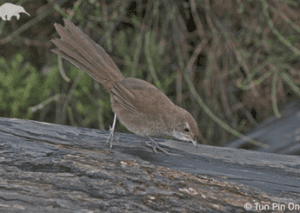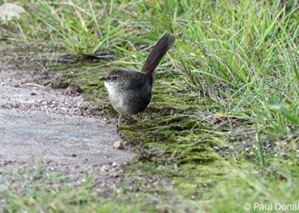TAG: GS 3: ECOLOGY AND ENVIRONMENT
THE CONTEXT: The release of eight captive-bred eastern bristlebirds into the wild at Border Ranges National Park marks a significant milestone in conservation efforts to save this critically endangered species.
EXPLANATION:
- Led by collaboration between government agencies and wildlife sanctuaries, the program aims to bolster the northern population of eastern bristlebirds, which faces imminent extinction due to habitat loss and fragmentation.
Species Status and Threats
- The eastern bristlebird population is dwindling, with fewer than 2,500 individuals remaining in the wild.
- The northern population, particularly vulnerable and critically endangered, is estimated to consist of fewer than 50 individuals.
- Habitat degradation, habitat loss, and invasive species pose significant threats to their survival.
- The captive breeding and release program represent a proactive response to mitigate these threats and prevent the extinction of the species.
Collaborative Conservation Initiative
- The success of the captive breeding and release program hinges on collaboration among various stakeholders, including the NSW Department of Planning and Environment, Queensland’s Currumbin Wildlife Sanctuary, and the NSW National Parks and Wildlife Service.
- Through concerted efforts, the program seeks to augment the genetic diversity and resilience of the northern population of eastern bristlebirds, thereby ensuring the long-term viability of the species.
Release and Monitoring
- Each released bird is equipped with a radio transmitter and identification bands to facilitate monitoring and tracking in the wild.
- Early observations reveal promising signs of the captive-bred birds integrating and bonding with the wild population, fostering optimism among conservationists.
- The program’s success is underscored by the careful preparation and acclimatization of the birds to their natural habitat, ensuring their ability to survive and thrive in the wild.
Preparation for Survival
- Extensive measures are undertaken to prepare captive-bred birds for life in the wild.
- These include weaning the birds from parental care, familiarizing them with wild foods and foraging behaviors, and simulating natural habitats to encourage socialization and adaptation.
- Such preparatory measures enhance the birds’ chances of survival and successful integration into the wild population, contributing to the overall success of the conservation program.
Future Directions
- The captive breeding and release program are part of a broader conservation strategy aimed at restoring habitat and population levels of eastern bristlebirds.
- With plans for biannual releases over the next nine years, the program demonstrates a long-term commitment to species recovery and ecosystem restoration.
- Concurrent efforts to restore grassy understorey habitats are integral to the program’s success, highlighting the importance of habitat restoration in species conservation.
Border Ranges National Park:
- The Border Ranges National Park is a protected national park that is located in the Northern Rivers region of New South Wales, Australia.
- A small portion of the national park is also located in South East Queensland. The 31,729-hectare (78,400-acre) park is situated approximately 150 kilometres (93 mi) south of Brisbane, north of Kyogle.
- The park is part of the Shield Volcano Group World Heritage Site Gondwana Rainforests of Australia inscribed in 1986 and added to the Australian National Heritage List in 2007.
- The Border Ranges region, which includes the McPherson Range, Tweed Range, Lamington Plateau and Levers Plateau, were formed from the erosion of the Tweed Volcano over many years.
- A number of volcanic plugs remain in the Border Ranges National Park.
Eastern bristlebird:
- The eastern bristlebird (Dasyornis brachypterus) is a species of bird in the bristlebird family, Dasyornithidae.
- It is endemic to Australia. Its natural habitats are temperate forests, temperate shrubland, and temperate grassland. It is threatened by habitat loss.
- The eastern bristlebird is very territorial and will often use a distinct, loud melodic song to mark its territory.
- Surveys have found the bird prefers to live in small, localised populations, and prefer to build their nests on the ground in areas of dense, clumped grasses.
- This species is often found in open woodland, adjacent to rainforest. Preferred habitats tend to be dominated by a Eucalyptus canopy with a dense ground cover.
- This species feeds predominantly on invertebrates, usually ants, beetles, cockroaches, orthopteran and caterpillars. Individuals also eat a large number of seeds and fruits.
- It has been listed as Vulnerable as per the IUCN Red List of Threatened Species.



